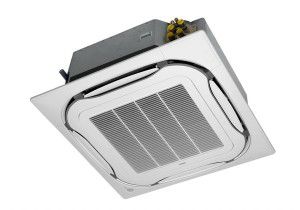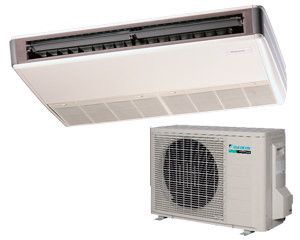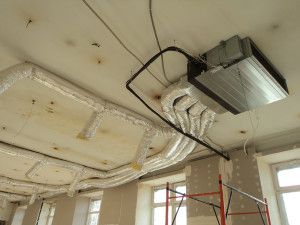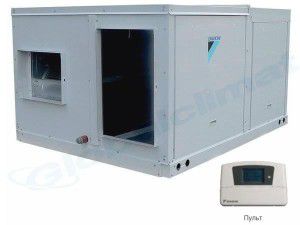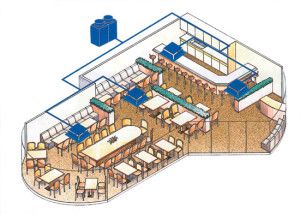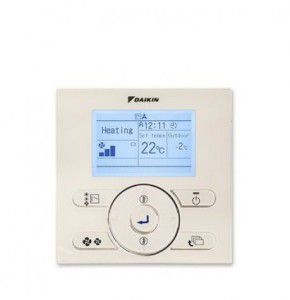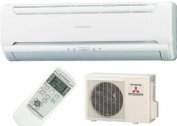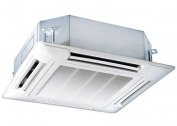The Japanese company DAIKIN, engaged in the production of HVAC equipment and heating equipment, takes the leading position among the other manufacturers of this product sector. Why are DAIKIN air conditioners recognized as the best, for what specifications and additional options?
Why DAIKIN: 3 reasons
Firstly, at this company all equipment is subdivided into household, commercial and industrial.
The household section mainly includes split- and multi-split systems, which, thanks to the new technologies introduced, optimize living conditions in apartments, residential buildings or in small offices and shops.
Commercial equipment is represented by a very large model range of technical solutions for restaurants, hotels, banks, sports facilities and similar organizations. These include chillers, fan coils, VRV systems and the SKY-AIR class of air conditioners with wall, duct, cassette and sub-ceiling types of indoor units.
DAIKIN industrial air conditioners include equipment such as inverter-controlled VRVs, modular systems with the ability to integrate air conditioning, industrial capacitors, precision air conditioners, chillers and other high-performance configurations. They are used in various industries and agriculture, where technological cooling / heating facilities have large areas and complex architectural solutions, and also require the proper organization of a microclimate to maintain the “life” of production plants and compensate for significant heat surpluses.
Secondly, many manufacturers do not have the additional options that DAIKIN offers. For example, its new splits have a unique Ururu Sarara air treatment system, which provides humidification without additional water supply, and drains without cooling, which makes the room climate comfortable at any given temperature. In fact, it is an air conditioner with a built-in humidifier and air purifier.
Thirdly, this Japanese manufacturer has a whole series of only outdoor units of DAIKIN air conditioners or only indoor. This is due to the fact that the device equipment of this climate technology is very "flexible", so they can be combined with each other from different series. This fact significantly expands the boundaries of consumer choice and gives more opportunities in the design of facilities.
Types of air conditioners DAIKIN
The offer of the range is decent: splits with various types of indoor units, the so-called "cartoons", VRV with the ability to connect up to 20 indoor units, fan coil units, chillers, roof air conditioners and other types of air conditioning systems.
This article discusses the most popular and sought-after DAIKIN air conditioners that you can buy in Russia.
Wall systems DAIKIN
Splits with wall-mounted indoor units are distinguished by their non-trivial design. Aesthetic contours and lines that correspond to the trends of modern style trends, embodied in a curved panel. Original colors, compact forms, wide shutters - all these qualities are possessed by the split systems of the EMURA, SKY INVERTER, URURA SARARA series.
This wall-mounted equipment belongs to the premium class, therefore the optional saturation and technical characteristics of DAIKIN wall-mounted air conditioners are impressive:
- high performance combined with reasonable energy efficiency due to the rotary compressor for most models and energy-saving functions - automatic filter cleaning and a 2-zone presence sensor;
- new safe refrigerant R32;
- extended operating temperature range;
- noise level up to a maximum of 19 dBA;
- double air intake and volumetric air flow;
- 5 methods of air treatment - humidification, drainage, ventilation, cleaning, heating / cooling;
- Online controller for controlling the air conditioner via the Internet or telephone.
Low energy consumption, excellent performance and reduced carbon dioxide emissions are what DAIKIN standard wall split offers.
DAIKIN cassette systems
The external unit of the DAIKIN cassette air conditioner is located outside, while the internal unit with all communications is masked under a false or false ceiling. In the observation area there is only a decorative distribution grid fixed in a single plane along the ceiling line. This is an ideal solution for rooms from 40 m² to 150 m², as well as where severe savings in usable area are required when connecting.
Among buyers, DAIKIN semi-industrial (SKY class) cassette air conditioners, for example, the FHYC, FCQ, FFQ and FHYK series, are in good demand, as they give excellent technical indicators and have a number of convenient options. And this:
- power, which makes it possible to quickly reach the specified air parameters;
- low noise level;
- antibacterial surface of the remote control;
- the ability to combine them into Twin, Triple or Double Twin systems;
- automatic mode selection and restart;
- protection against extreme temperatures;
- a mixture of fresh air;
- powerful filtering system;
- compulsory drainage of condensate;
- economical night mode;
- self-diagnosis function in case of malfunctions;
- weather accounting function;
- absence of ceiling contamination due to a special algorithm for moving the dampers.
Many buyers unanimously believe that DAIKIN cassette air conditioners are a stylish climate technology that optimizes the conditions for people in various public areas, as well as completely controlled settings to create comfort.
DAIKIN ceiling systems
An ideal room for a DAIKIN ceiling air conditioner should have an area of up to 150 m² and a ceiling height of up to 4 m. Such designs are placed as follows: the device itself is fixed to the ceiling, and communications are masked. This is also a SKY class technique.
Typically, DAIKIN sub-ceiling air conditioners are available with 1, 2, 3 or 4-line indoor units. The choice of the number of flows depends on the shape of the room and the location of the device itself. The FHY and FHQ series distribute air in one direction, and the FUY and FUQ - two, three or four. First, the air masses are taken through the grill in the front panel, and then along the ceiling go into the room. For the flap to swing in the right direction, you must set the ceiling height with the remote control.
In addition, DAIKIN ceiling air conditioners have other advantages:
- inverter technology that reduces noise and increases energy efficiency;
- a mixture of oxygen;
- effective air distribution vertically and horizontally;
- automatic maintenance of permissible humidity level;
- anti-mold filter processing;
- economical mode of operation in the absence of people in the room with a quick return to recreate comfortable conditions when they appear;
- protection of the heat exchanger of the outdoor unit from frost;
- condensate rise through the drain pump.
Ceiling air conditioning systems can also work in multi-split and VRV systems as their components.
This is an ideal working environment without harming the environment and energy-efficient for many years to come.
Channel DAIKIN systems
Using duct DAIKIN air conditioners, you can cool huge areas (up to 250 m²) of one or more rooms. In this case, only one external unit is required, to which several internal ones are connected. The latter is sewn under the final ceiling or wall, making the installation completely invisible.
The channels through which cool air enters the external unit are insulated (to prevent condensation) and insulated. This type has the ability to mix fresh air through an extensive network of ducts - up to 30% of the total volume of air masses.
DAIKIN air conditioners with duct indoor unit distinguish 3 categories:
- low pressure - with a pressure of up to 40 Pa, they process small rooms with high noise requirements (FDX series);
- medium pressure - with a pressure of up to 100 Pa, they process larger rooms, have a noise level of up to 29 dBa due to aerodynamic noise in the channel (FBQ series);
- high pressure - with a pressure of up to 250 Pa, power up to 26 kW in heating mode and a large length of channels (FDQ series).
All categories support the microclimate in two ways: by observing precisely set parameters in the local area or by achieving approximately general values throughout the room. In addition, ducted air conditioners have a number of additional advantages:
- noise reduction mode of both units;
- electronic power control;
- swinging rotor for contact with a harmless refrigerant;
- mold filter;
- automatic control of normal air humidity;
- self-diagnosis functions, night saving and the absence / presence of people in the room;
- anticorrosive processing of materials.
This is not all the technical characteristics and functions of DAIKIN air conditioners of channel type. Each series and model may have additional features. But a special plus is the multisystem layout, which reduces the number of outdoor devices, preserving the appearance of the building and saves space, since it is not always possible to accommodate several outdoor units.
It is necessary to accurately calculate the length of the route so that the freon normally reaches the indoor unit, correctly design the system to avoid excessive air supply through one duct and insufficient over the other. You also need to thoroughly fix the air ducts and select high-quality material for them, otherwise expensive equipment will emit extraneous noise.
Industrial DAIKIN systems
The main distinguishing feature of DAIKIN industrial air conditioners is their power, the values of which start from 7 kW and reach huge values. Such equipment is installed in institutions with a large area and having strict requirements regarding the supported air parameters - medical laboratories, server rooms, warehouses, banks and so on.
At DAIKIN, all industrial air conditioners perfectly maintain the set temperature, humidity level and make it possible to preinstall. The model range includes roof air conditioners (UATYQ-C series), screw (EWAD-TZ series) daikin inverter air conditioners (EWAD-AJYNN / S series), cabinet units (UCPJ series) that work only for cooling, but with excellent cooling performance up to 189 kW, multi-zone VRV and VRF systems and other high-tech equipment.
By the way, monoblock roofs are an inexpensive option for large-sized premises such as shopping centers and department stores. Another plus is the simple installation carried out on the roof or next to the building itself. It provides energy saving during free cooling during transitional seasons - the outside air is used for cooling inside, and this saves electricity.
DAIKIN precision systems
When it comes to maintaining the temperature in the server room (data center), DAIKIN air conditioners can be converted to precision.They are installed where it is important to create conditions with an accuracy of tenths of a degree and a deviation in humidity of no more than 2.5%, as well as regulate the content of harmful microparticles in the air during a continuous production process.
All precision air conditioners from DAIKIN are divided into devices:
- air-cooled coolant - consist of an indoor unit with the main components of the device, and an outdoor (remote) installed outside the premises;
- water cooled coolant - consist of one unit with a water condenser located inside, the heating mode is carried out by a built-in electric heater, and not a heat pump;
- with mixed coolant cooling - It has 2 circuits: Freon and water, the principle of which is to transfer heat from the first to the second, and in turn, the water through an external heat exchanger removes an excess of heat.
The first two types are single-loop, unlike the latter.
In some series, DAIKIN roof air conditioners are equipped with the “Free Cooling” control system, which, when lowering the external t ° of air, uses its cold flows coming through the air ducts for internal cooling. This greatly saves energy.
A DAIKIN precision air conditioner for a server room can have different methods of air supply: upper and lower. In the first version, the transmission goes through the air conditioner itself and the ceiling ducts, and in the second - through the air distributors from the raised floor.
Judging by the reviews, the following advantages can be attributed to additional advantages of air conditioners for the server room from DAIKIN:
- fan power, which exceeds the standard values in three times the size;
- a huge range of workers t ° - from -45 ° to + 50 ° on the street (the rest of the industrial limit is -15 °);
- high performance in the cold, reaching 300 kW in some models;
- support for accurate preset parameters by the built-in microprocessor;
- round-the-clock and year-round uninterrupted operation of the system.
All industrial climate systems from DAIKIN are characterized by long-term operation without breakdowns. But at the same time, several conditions must be observed: accurate design, taking into account all the features of the building, installation only by experienced professionals and regular maintenance.
When designing in case of equipment failure, it is necessary to provide at least 50% redundancy and an immediate system for warning of malfunctions.
Outdoor and indoor units for multi-split systems and VRV systems
As mentioned earlier, DAIKIN produces separate series of outdoor and indoor units, which can have different layout options among themselves in multi- and VRV-systems.
An example is the Super Multi Plus system, which is designed for installation in cottages, large apartments, salons, that is, where there is a small group of rooms. The external units of the DAIKIN air conditioner in this series have a cold power from 11.2 kW to 15.5 kW and are combined with Split and SkyAir class indoor units. At the same time, the external unit of such a DAIKIN air conditioner can be combined with 9 internal in one system.
There are also a number of internal devices of various types that are suitable for working with external devices in the MXS multisystem.
This expands the boundaries of the choice of equipment, and also makes it possible to solve complex technical problems.
Instructions for DAIKIN remote controls
Like all other manufacturers, DAIKIN has operating instructions for all series and models of air conditioners. They include a standard set of operating recommendations, descriptions of performance and additional options, installation tips and, of course, detailed instructions for the DAIKIN air conditioner remote control with all the rules for installing various modes.
We can say that the last point is one of the most important, since there are given detailed settings for setting the main modes of cooling, heating, drainage, ventilation and cleaning. The instructions for the DAIKIN air conditioner control panel explain how to enable the "Timer" function, how to adjust air flow or enable economy mode.
The basic instructions for DAIKIN air conditioners also contain important information about cases of malfunctions that are not malfunctions. For example, if an operation suddenly stops and the “Operation” lamp lights up, this means that the protective stop of the operation of the device is triggered by significant voltage fluctuations. Usually, renewal occurs after 3 minutes.
Error codes for air conditioners DAIKIN
Also, the instruction manual for the DAIKIN air conditioner remote control has important information about fault codes that require urgent service. In another way, they are called error codes for DAIKIN air conditioners, which are divided into errors:
- systems;
- indoor unit;
- outdoor unit.
All errors of DAIKIN air conditioners have their own alphanumeric designation, that is, a code. For example, remotes for daikin air conditioners or instrument panels of the FTK20GV1B model showing error U0 indicate a lack of refrigerant.
When buying, you should immediately check the complete set of purchased equipment and the availability of instructions including.
DAIKIN Customer Reviews
In almost 100% of cases, reviews of DAIKIN air conditioners contain only positive reviews from both customers and service centers.
Of course, the price of HVAC equipment from this manufacturer is higher than that of other manufacturers, but the quality of the equipment purchased justifies this. Here are the main characteristics that users give in their reviews of DAIKIN air conditioners, both industrial and domestic:
- chic design of any models of split systems;
- silent operation of both blocks;
- reliability and duration of operation;
- multifunctionality;
- high energy efficiency class in most series;
- thoughtful direction of air flow → lack of colds;
- inflow of fresh air;
- built-in humidifier and air mass cleaner.
By the way, for those who have children, systems with the “smart eye” function, which carries out airflow from a person, are simply irreplaceable.
DAIKIN is real climate control. The system will not break in two to three months and is unlikely to disturb neighbors with its noise, so the reviews for these air conditioners are justified and proven by a practical method.
The main thing is to entrust the installation of equipment to competent specialists, in order to then enjoy full comfort in hot summer days and dank autumn-spring off-season.


